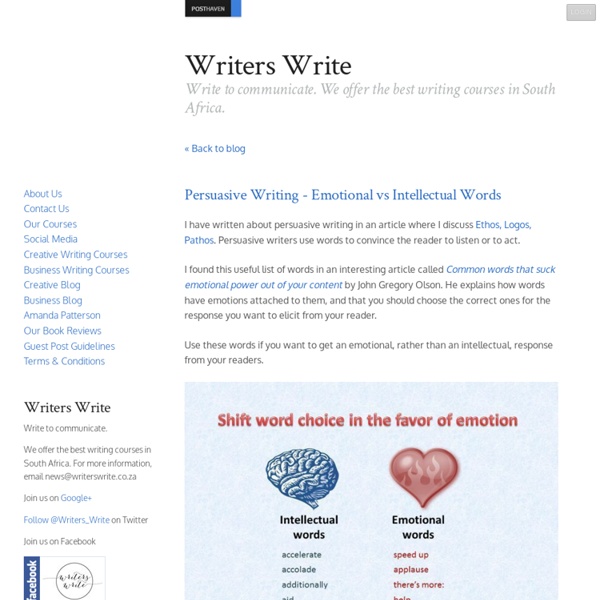



http://writerswrite.co.za/persuasive-writing-emotional-vs-intellectual-words
Related: Vocabulary • kcmmnem • Parole, parole, parole'Ogooglebar' ... and 14 Other Swedish Words We Should Incorporate Into English Immediately Köttrymd! In other words, everything's better in Swedish. (Oliver Hoffman/Shutterstock) Today brought the news that Google has officially objected to one of the best words that has ever graced this planet: ogooglebar, which translates -- if such a glorious word must be subjugated to the indignities of translation -- to "ungoogleable." Synonyms for words commonly used in student's writing Amazing- incredible, unbelievable, improbable, fabulous, wonderful, fantastic, astonishing, astounding, extraordinary Anger- enrage, infuriate, arouse, nettle, exasperate, inflame, madden Angry- mad, furious, enraged, excited, wrathful, indignant, exasperated, aroused, inflamed Answer- reply, respond, retort, acknowledge
12 Awesome Language Resources for the Word Nerd I’m an unabashed word nerd. I majored in English and have been a high school English teacher for almost 30 years. I run an online program helping homeschoolers develop writing skills, and I manage this wordy blog and a wordy Facebook page. FREE “Word ADDiction” Worksheet/Team... by Laura Randazzo Know that awkward moment when you’ve finish a lecture early, all questions have been answered, and there’s still – yikes! – 10 minutes left in the period? Or do you have one of those classes that seems to finish everything about 15 minutes earlier than all of your other sections? The solution is to keep ‘em busy until the end of the hour with fun and meaningful activities. This handy “Word ADDiction” print-and-teach worksheet was built to help fill all available class time. The handout can be used as an in-class or homework assignment, substitute teacher materials, or game/contest sheet.
How To Use Google For Hacking Google serves almost 80 percent of all search queries on the Internet, proving itself as the most popular search engine. However Google makes it possible to reach not only the publicly available information resources, but also gives access to some of the most confidential information that should never have been revealed. In this post I will show how to use Google for exploiting security vulnerabilities within websites. The IKEA Dictionary By Lars Petrus This site is not affiliated with IKEA in any way. Part of what makes IKEA unique is their product names. Horse race dictation It is enjoyable because students are asked to predict the first word, in the same way people try to guess which horse will come first in a race, giving a strong motivation for the short but very intensive listening activity, in the form of a horse race commentary, which gives the solution. Preparation Choose a sentence and write words in random order on the left of the board, as in the example below. You also need to prepare a commentary, which should be challenging enough to make it interesting but not too difficult. In the example below there is only one major change in order, when, and other minor changes during the race. finallywaso’clockelevenhomewhenIitgot
10 Important Google URLs That Every Google User Should Know Which websites and apps have background access to my Google account? What does Google know about me? Where can I see all the ads that I’ve clicked on Google search? What does Google know about the places I’ve visited recently? Where should I go if I have forgotten the administrator password for Google Apps? Transitional Words & Phrases Using transitional words and phraseshelps papers read more smoothly, and at the same time allows the reader to flow more smoothly from one point to the next. Transitions enhance logical organization and understandabilityand improve the connections between thoughts. They indicate relations,whether within a sentence, paragraph, or paper. This list illustrates categories of "relationships" between ideas,followed by words and phrases that can make the connections: Addition: also, again, as well as, besides, coupled with, furthermore, in addition, likewise, moreover, similarly
10 Do's and Don'ts for Effective Vocabulary Instruction l Dr. Kimberly's Literacy Blog We know that there is a strong relationship between vocabulary and reading comprehension. Systematic vocabulary instruction must be an integral component of a K-12 comprehensive instructional framework While there is no one correct way to teach vocabulary, common characteristics of effective vocabulary instruction have been documented in many professional journals and books. Power Google www.google.com Welcome to Power Google, By Robert Harris, a practical, how-to book about using Google to locate information on the Internet. Below you will find a brief description of each chapter’s content along with two formats in which they can be viewed (Adobe® or HTML). If you do not have an Adobe® Acrobat® reader or would like to update your current reader to the latest version, click on the Adobe® icon below for a free download. Please note: Download times will depend on the Internet connection. Chapter 1: Why use Google?